france
new! Cathedrale Saint-Gatien at Tours 
 updated: Romanesque churches and cathedrals in south-west France updated: Romanesque churches and cathedrals in south-west France
the perpendicular or English style of cathedral 
the fire at the cathedral of Notre-Dame de Paris

cathedral giants - Amiens and Beauvais
Stone tracery in church and
cathedral construction 
stone in church and cathedral construction stained glass and cathedrals in Normandy  
fortified churches, mostly in Les Landes
cathedral labyrinths and mazes in France
using metal in gothic cathedral construction
Germans in France
cathedral destruction during the French revolution, subsidiary page to Germans in France

on first arriving in France - driving
France is not England
paying at the péage (toll station)

Transbordeur bridges in France and the world 2: focus on Portugalete, Chicago,
Rochefort-Martrou
Gustave Eiffel’s first work: the Eiffel passerelle, Bordeaux
a fifth bridge coming to Bordeaux: pont Chaban-Delmas, a new vertical lift bridge
France’s western isles: Ile de Ré
France’s western iles: Ile d’Oleron
Ile de France, Paris: in the context of Abelard and of French cathedrals
short biography of Pierre (Peter) Abelard
Marianne - a French national symbol, with French definitive stamps
la Belle Epoque
Grand Palais, Paris


Pic du Midi - observing stars clearly, A64
Carcassonne, A61: world heritage fortified city
Futuroscope
Vulcania
Space City, Toulouse
the French umbrella & Aurillac
50 years old:
Citroën DS
the Citroën 2CV:
a French motoring icon
the forest as seen by Francois Mauriac, and today
Les Landes, places and playtime
roundabout art of Les Landes
Hermès scarves

bastide towns
mardi gras! carnival in Basque country
country life in France: the poultry fair
what a hair cut! m & french pop/rock
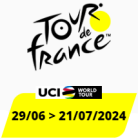
Le Tour de France: cycling tactics 
 |
- index
what is tracery?
plate tracery
bar tracery and tracery design
- transoms
- bibliography
what is tracery?
Tracery is a decorative method of providing the stone framework, and so the support needed, in windows of great spans. Tracery can also be found in rose windows. Stone tracery is also a common form of decoration in towers, as chapel dividers, and even garden walls, where glass is not inserted. Similar patterning appears with other materials, such as wood. Another form is 'blind tracery', where stone is carved out of a stone, thin slab or 'plate', without cutting deeply enough to make holes. In contrast, this present page focuses on assembling carved stone blocks that together form tracery.
As buttressing developed to support the cathedral's structure, the outer walls between the buttresses were less necessary for carrying the loads of roof, forest, and upper stone structures. Thus, the intervening walls became curtain walls and could be pierced without compromising the cathedral's integrity. More and larger holes were cut through them, making windows. |
|
The window shape started as a single lancet, surmounted by a pointed (Gothic) arch. Gradually, several lancets were placed together to make larger windows. The natural gaps between the tops of the lancets demanded something be done, and were prettified with increasing complications of tracery patterns.
One of the prettifications was foils, shapes based on a symmetrical presentation of leaf shapes. A foil [origin: folium - leaf, Latin] is consructed by overlapping circles make a number of cusps on a lobe. Three cusps create a trefoil, four cusps a quatrefoil (as in the labelled photo below), five a cinquefoil, six cusps a sexfoil, while seven cusps make a septfoil, and so on. [The number prefixes are a mixture of Latin, French and a sort of pig-Latin, as took the fancy of the words' inventors.]
The stained glass as a whole needed support within the windows, so thin, carved supports of stone were developed, arranged and assembled into … tracery. The individual pieces of glass within the panes were held and supported by leading and wider iron bars. You will find the normal supporting shapes in tracery such as pointed and rounded arches. In the case of the rose window the shape is the wheel, which can be viewed as a continual Roman (rounded) arch.
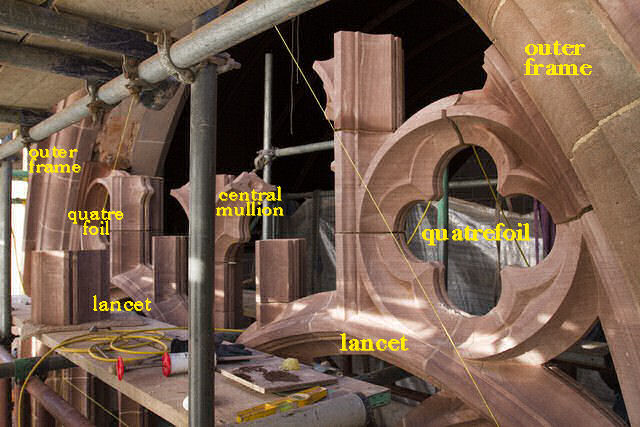
Tracery being built. (Image: htss.org)
The assembled pieces of carved stone have been secured to one another by various methods - iron rods, iron rods covered in lead, lead 'blobs' designed to stop the individual stones slipping against one another, and nowadays stainless steel pins and fine lime mortar. The result is a piece of stone tracery, ready to receive leaded stained glass.
The assembled tracery is made part of the curtain wall between buttressing that supports the building structure. Load-bearing walls are often made of interior and exterior walls, the space between being filled with building rubble. When a window is introduced into the exterior wall, there is complex stonework connnecting the exterior wall to the interior one - see the diagram just below. To enable the light entering through the window to spread, there are sloping, vertical walls, similarly to arrow slits in medieval fortifications (coloured yellow in the diagram below).
- The diagram below shows, to the left, a cross-section of the wall from inside to outside, while on the right is a face-on view from inside.
- The black arrows link some of the same items on the
cross-section and on the face-on view.
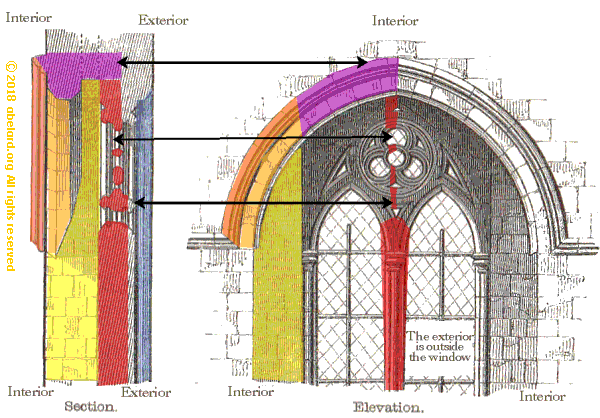
How a tracery window is embedded in a church/cathedral wall.
- The various colours match the different parts of the interior arch and wall, both on the cross-section and on the face-on view.
- In particular, the crimson parts (see the face-on view to the right) are on the line of the cross-section.
- The tracery and the window can be regarded as part of the exterior curtain wall.
- The blue-coloured part on the cross-section is outside the building, and is the surround of the inset window.
Being at 90° to the wall, this blue-coloured part does not obscure the window glass, nor can it be seen in the face-on view above.
The exterior view of plate tracery below shows how the ridges and insets around the glass will appear to be obscuring the glass if the window is sliced through.
|
plate tracery
Plate tracery was the early method of providing support within a window space for the glass.
Plate tracery was constructed from carefully shaped and jointed pieces of masonry. They were inserted into the surrounding wall's thick areas of stone in order to support and separate glazed areas. The window may look as if it had been filled in with glass by making a stone 'plate', and then small openings cut through the plate for the glass, but this not the case - plate tracery is formed in sections just like other tracery. With plate tracery, the stone rather than the glass dominates the window.
bar tracery and design
As the stone masons mastered cutting thinner, yet still strong, straight and curved stone sections, the more elaborate the bar tracery became. The resulting ornately designed windows were predominately glass. Notice that distinctions between plate tracery and bar tracery border on the artificial.
The stone framework that is tracery can be classified generally into two groups - geometric and curvilinear.
The early and simpler designs of geometrical tracery evolved into the more intricate curvilinear designs as the masons' skills increased and the artists became even more creative as they sort to top their predecessors.
The large windows made up of several lights (sections) developed from several lancet windows that were placed closer and closer together, until the various lancets were an integrated ensemble, divided vertically by mullions.
transoms
Unusually can be found stone transoms in England. I would expect the rarity to be due to the stresses on stone in bending and sheering (tension, stretching) making such structures much more unreliable and likely to fail. Here are examples from Oxford and Winchester. Notice that in the Oxford example the transom is supported by arches, as is the case with the top of almost all other windows. In the Winchester example, the short transoms are supported by the vertical mullion and the side walls. This function of transoms is usually taken by iron or steel bars, to which stained glass windows are attached using wire twists.
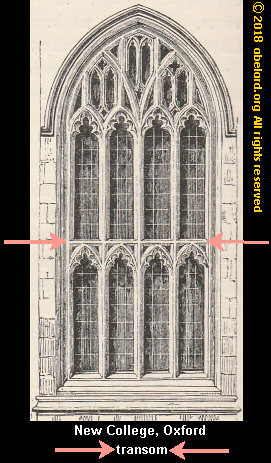 |
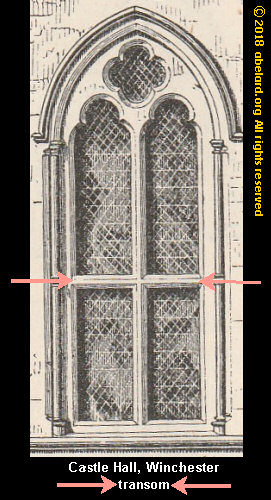 |
The following two windows are regarded as amongst the best in Britain. The left window is of the geometrical style, while the right-hand one is of the decorated or curvilinear style. They are both over thirty feet wide [9.1 metres] and nearly 60 feet high [18.3 metres]. Notice that the Lincoln window (left) has eight lancets and so an even number, whereas the Carlisle window has nine lancets. See how this affects the design of the tracery. Notice also the patterns of gothic arches, within gothic arches, within gothic arches. The west window at York, which has eight lancets, has its tracery forming heart shapes.
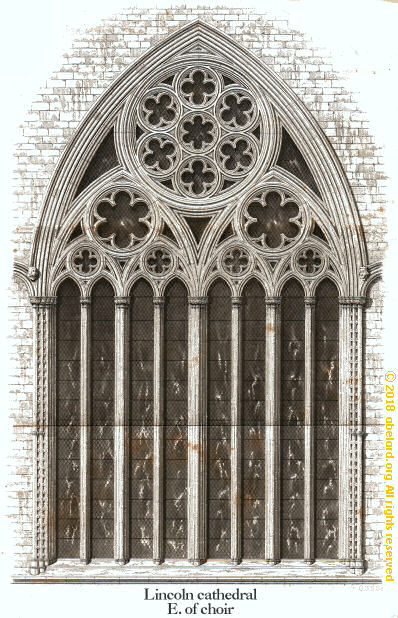
Eight-lancet (light) window, Lincoln cathedral
probably late 13th century |
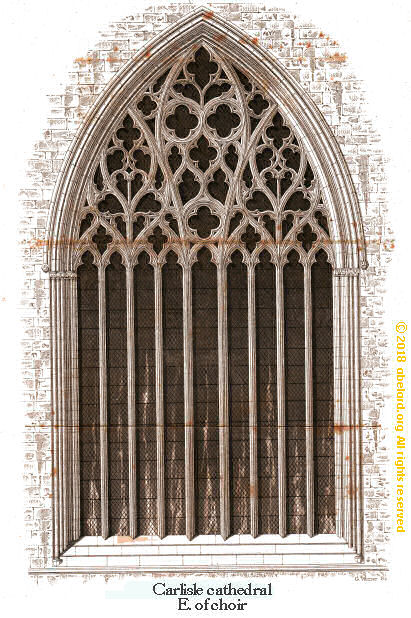
Nine-lancet (light) window, Carlisle cathedral
mid-14th century |
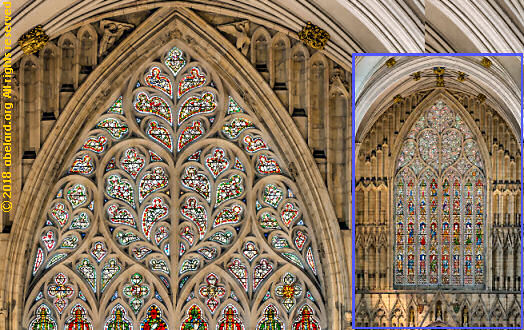
Detail of tracery in the west window of York Minster with a heart-shaped design (insert shows the full window)
|
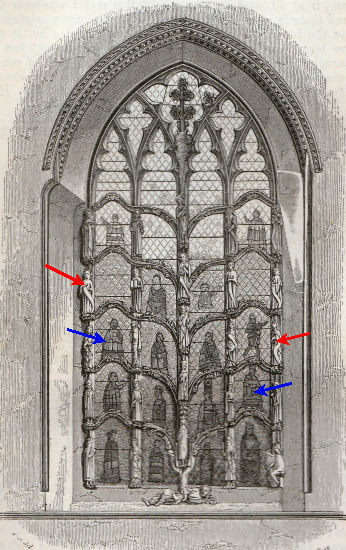
The Jesse window, Dorchester, Oxfordshire, c. 1320
(from Rickman, styles of architecture in England)
At Dorchester, Oxfordshire, the tracery has been structured as the Jesse tree rising from the loins of Jesse, father of David. This window is very unusual as it combines stone and glass in its design, and the tracery carved as the Jesse tree's branches. Two examples of stone figures are marked with red arrows, while two figures on glass are marked with blue arrows. More common, but still unusual, is the botanic-like moulding of the other tracery. |
bibliography
A treatise on the rise and progress of decorated window tracery in England
Volume 1-2; Illustrated with ninety-seven woodcuts and six engravings on steel
by Edmund Sharpe |

|
John Van Voorst, Paternoster Row,
London,
hbk, 1849 |
Note, this is a book with two volumes, one that is mainly text, the other being mostly plate illustrations.
Modern reprints or reproductions often appear to offer just the first volume, or the book printed as one volume only.
The woodcut and similar non-photographic illustrations are taken originally from the 1849 edition of this book. Some are from vol.1 and others from vol.2. |
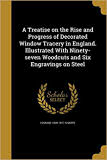 |
Wentworth Pres, pbk, 2016
ISBN-10: 1374490202
ISBN-13: 978-1374490208
$12.95 (amazon.com)
£9.69 (amazon.co.uk) |
|
Storied windows - A traveller's introduction to the study of old church glass, from the twelfth century to the Renaissance, especially in France
by A. J. de Havilland Bushnell |
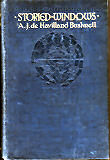 |
William Blackwood and sons,
hbk, 1914 |
|
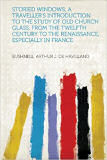 |
HardPress Publishing, pbk, 2013
ISBN-10: 131445367X
ISBN-13: 978-1314453676
$14.95 (amazon.com)
£10.95 (amazon.co.uk) |
|
|
The art and craft of stained glass
by E. W. Twining |
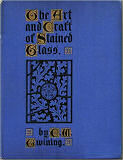 |
Sir Isaac Pitman & Sons, Ltd.
hbk, 1928
ASIN: B000SNSF4M
$94.89 (amazon.com)
£57.90 (amazon.co.uk) |
|
|
English mediæval stained glass
by J. D. Le Couteur |
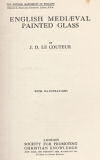 |
Society for promoting Christian knowledge [S.P.C.K.], Macmillan Co., London
hbk, 1926 |
|
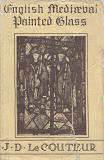 |
ASIN: B005FWA9AE
$19.95 (amazon.com)
amazon.co.uk |
|
|
An introduction to the study of gothic arichitecture
by the late John Henry Parker C.B. , Hon. M.A. Oxon, F.S.A. Lond. etc. |
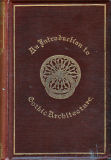 |
James Parker and Co., London and Oxford, 1895, hbk
[1st edition 1849]
ASIN: B00086WVK8
amazon.co.uk
amazon.com |
|
|
An attempt to discriminate the styles of architecture in England
from the Conquest to the Reformation
by Thomas Rickman |
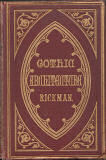 |
Parker and Co.,
London and Oxford,
hbk, 1881 |
|
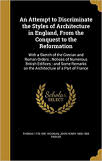 |
Wentworth Press, 2016
hbk
ISBN-10 : 1360037942
ISBN-13 : 978-1360037943
$43.15 (amazon.com)
£24.87 (amazon.co.uk) |
|
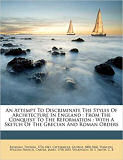 |
Nabu Press, 2010
pbk
ISBN-10 : 1172182884
ISBN-13 : 978-1172182886
$34.46 (amazon.com)
£18.99 (amazon.co.uk) |
|
|
The Early Iconography of the Tree of Jesse
by A Watson |
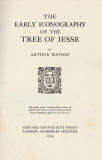 |
Oxford University Press, H. Milford
hbk, 1934
4to., pp.xiv, 197, (xl), navy cloth, gilt, b/w frontispiece, 40 b/w plates to rear of volume
ASIN : B001IQAAK0
amazon.com / amazon.co.uk |
|
|
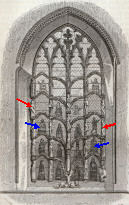 |
In Living Memory: Portraits of the Fourteenth-Century Canons of Dorchester Abbey
Sandler, Lucy Freeman. (2012)
In: Nottingham medieval studies vol. 56 (2012) p. 327-349 (22 pages) |
BrepolsOnline, Brepols Publishers NV
This publication is sold as a .pdf download of a journal article.
An individual can have "unlimited access" for $22.00 plus tax ($1.21), a total of $23.21.
"To gain access to your content, please go to: www.brepolsonline.net, log on to your account and navigate to your purchased content. If you have questions regarding this purchase, or require additional help, please contact us at Brepols Publishers NV" |
end notes
-
- transom
- the flat surface forming the stern of a boat.
a horizontal beam reinforcing the stern of a boat.
a strengthening crossbar, in windows or above a door.
|















